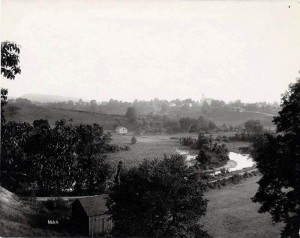 The Kirtland Safety Society was formed on November 2, 1836, in Kirtland, Ohio. Orson Hyde was sent to Columbus, Ohio, to petition the legislature for an act of incorporation to allow them to form their own bank. However, because Orson represented the Mormon Church, the legislature refused to grant the banking privileges which they had given to so many others so easily. As a result, the Kirtland Safety Society was formed as an anti-banking society. They drew up sixteen articles, in accordance with which the members of the society all agreed they would do business. Martin Harris refused to join, however. After clashing with Sidney Rigdon regarding the matter, and after things developed further, Martin Harris was released from the high council and was ultimately excommunicated in late December 1837. Martin Harris ultimately came back to the Church and was rebaptized on November 7, 1842, after which he joined the Saints in the West.
The Kirtland Safety Society was formed on November 2, 1836, in Kirtland, Ohio. Orson Hyde was sent to Columbus, Ohio, to petition the legislature for an act of incorporation to allow them to form their own bank. However, because Orson represented the Mormon Church, the legislature refused to grant the banking privileges which they had given to so many others so easily. As a result, the Kirtland Safety Society was formed as an anti-banking society. They drew up sixteen articles, in accordance with which the members of the society all agreed they would do business. Martin Harris refused to join, however. After clashing with Sidney Rigdon regarding the matter, and after things developed further, Martin Harris was released from the high council and was ultimately excommunicated in late December 1837. Martin Harris ultimately came back to the Church and was rebaptized on November 7, 1842, after which he joined the Saints in the West.
The purpose of forming the society was to allow members of the Church a means to get loans, so they could assist one another in building up the Church where they were. The society was not formed as part of the Church, but as a business through which the men could help other members of the Church. Joseph Smith never declared to have received commandment or revelation to form the society, but did feel he had been guided by the Spirit to pursue it. However, when things began to fail, as they did nationwide, many angry members of the society blamed Joseph exclusively and claimed he was a fallen prophet. Joseph pointed out to them it was their greed and speculation, as well as their failure to follow his counsel, which ultimately brought the society down.
Joseph described the atmosphere in May 1837, saying,
“At this time the spirit of speculation in lands and property of all kinds, which was so prevalent throughout the whole nation, was taking deep root in the Church. As the fruits of this spirit, evil surmisings, fault-finding, disunion, dissension, and apostasy followed in quick succession, and it seemed as though all the powers of earth and hell were combining their influence in an especial manner to overthrow the Church at once, and make a final end . . . The enemy abroad, and apostates in our midst, united in their schemes, flour and provisions were turned towards other markets, and many became disaffected toward me as though I were the sole cause of those very evils I was most strenuously striving against.”
Many people not only left the Church, but joined forces to fight against it. Some of the members of the Priesthood quorums (including the Quorum of the Twelve) turned against Joseph and even tried to hold the Kirtland Temple as their own. Those who remained faithful, though, still had the true Spirit of the Lord with them and realized Joseph was not to blame. They still recognized him as a true prophet and remained loyal to him and to the Lord.
This spirit of speculation which Joseph referred to was by no means confined to the Mormons. It swept the nation and caused countless banks to fail. New York City alone amassed more than $100,000,000 in failures. President Van Buren had to convene an extra session of Congress, “to provide for meeting demands on the treasury with legal currency.” This extra session lasted five or six weeks. Countless banks had been formed across the country, and many were printing their own notes, which caused a flooding of the marked with currency that had no value.
Eliza R. Snow, sister of one of the later presidents of the Church of Jesus Christ of Latter-day Saints, Lorenzo Snow, quotes him describing this spirit of speculation,
“Most of the Saints were poor, and now prosperity was dawning upon them—the Temple was completed, and in it they had been recipients of marvelous blessings, and many who had been humble and faithful to the performance of every duty—ready to go and come at every call of the Priesthood, were getting haughty in their spirits, and lifted up in the pride of their hearts. As the Saints drank in the love and spirit of the world, the Spirit of the Lord withdrew from their hearts, and they were filled with pride and hatred toward those who maintained their integrity. They linked themselves together in an opposing party—pretended that they constituted the Church, and claimed that the Temple belonged to them, and even attempted to hold it.”
Despite the tumultuous times, the Church not only survived; it thrived. Members who had remained faithful had strengthened testimonies, and all attempts to destroy the Church, Joseph, and the Saints resulted in failure.

 Watch a video about the restoration of the gospel on lds.org
Watch a video about the restoration of the gospel on lds.org